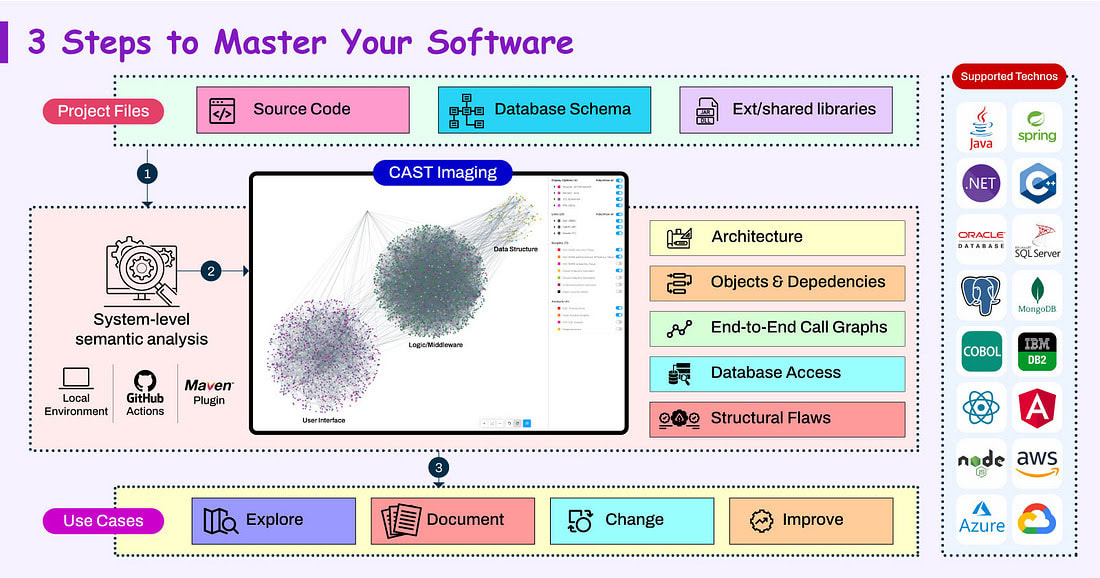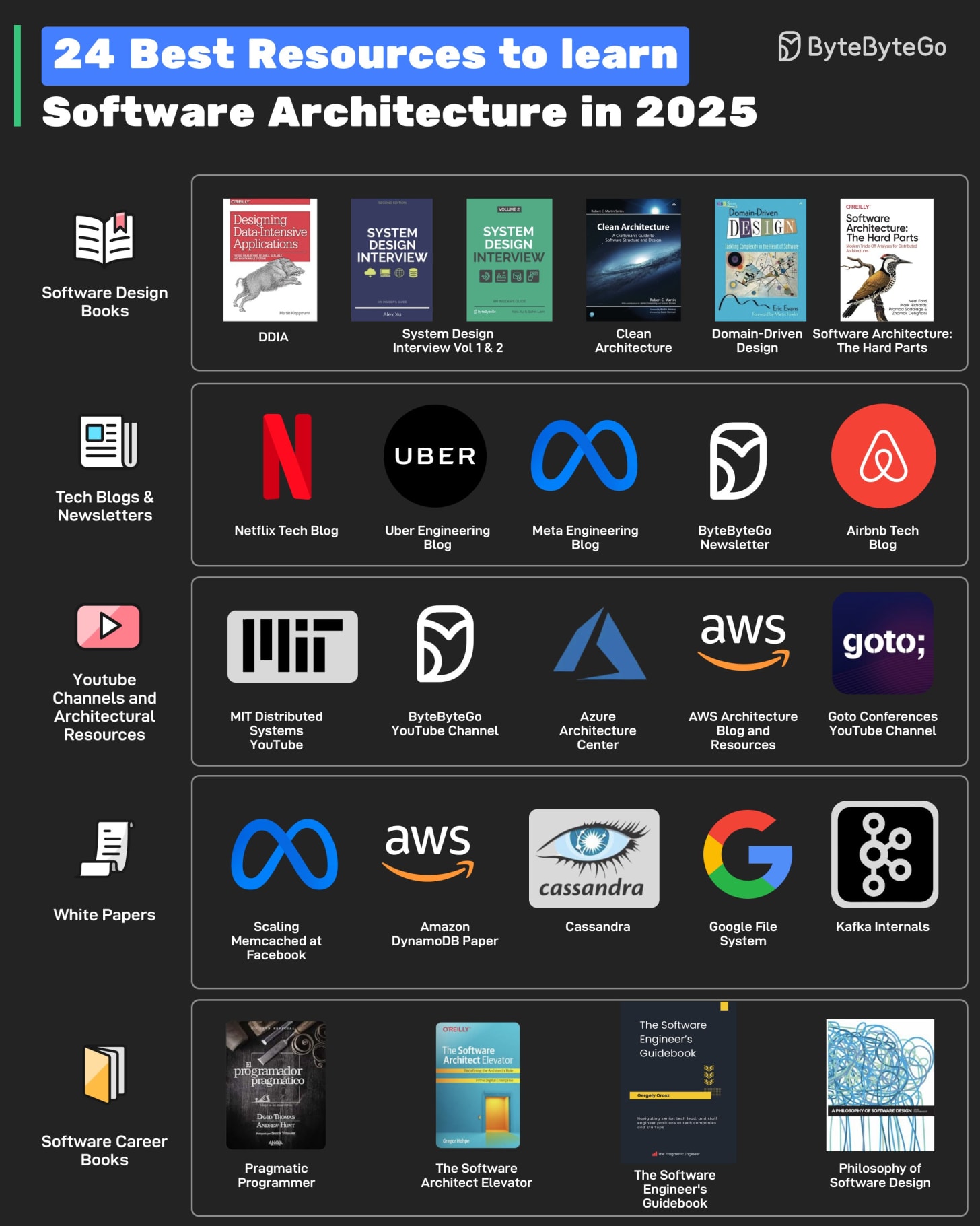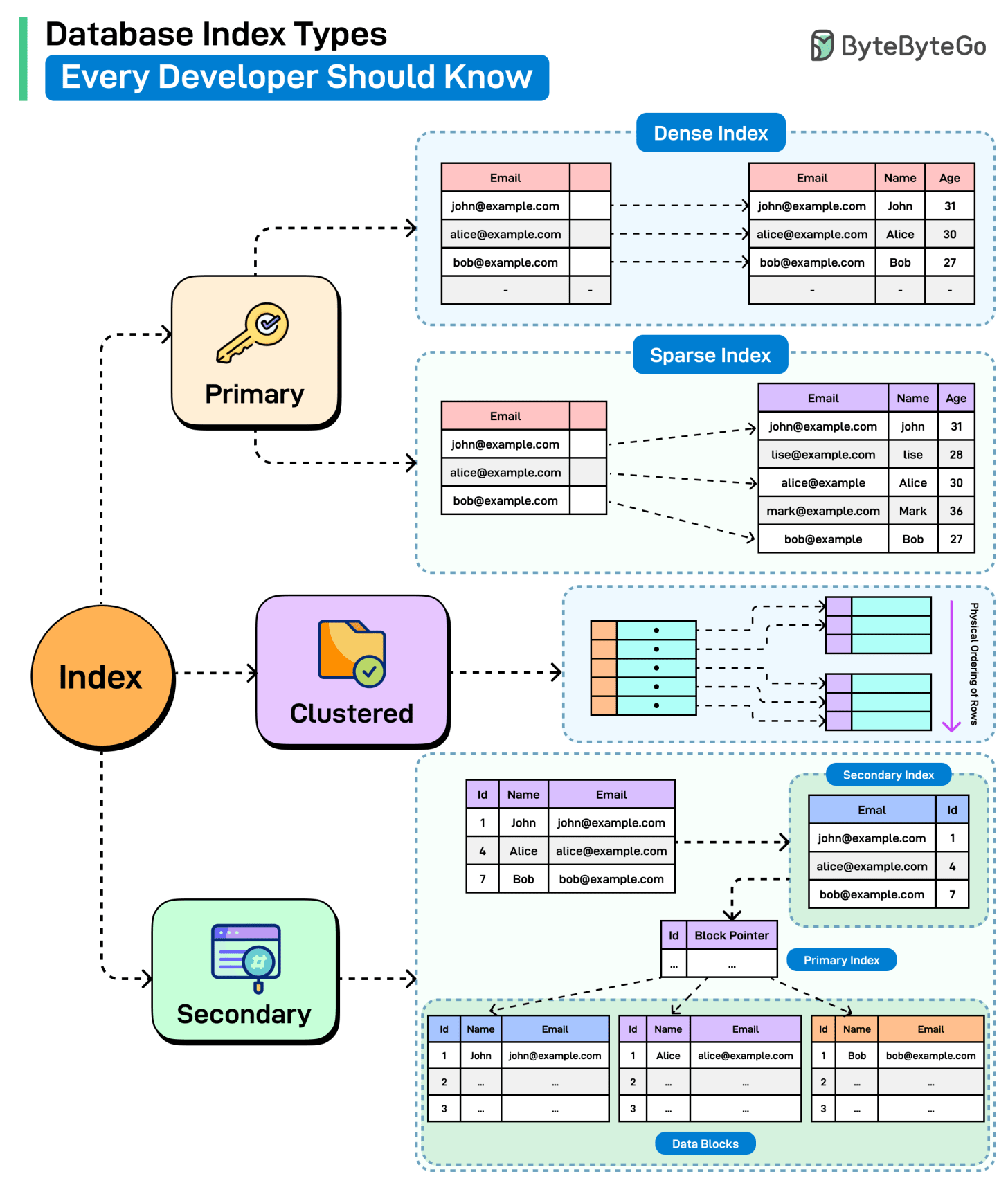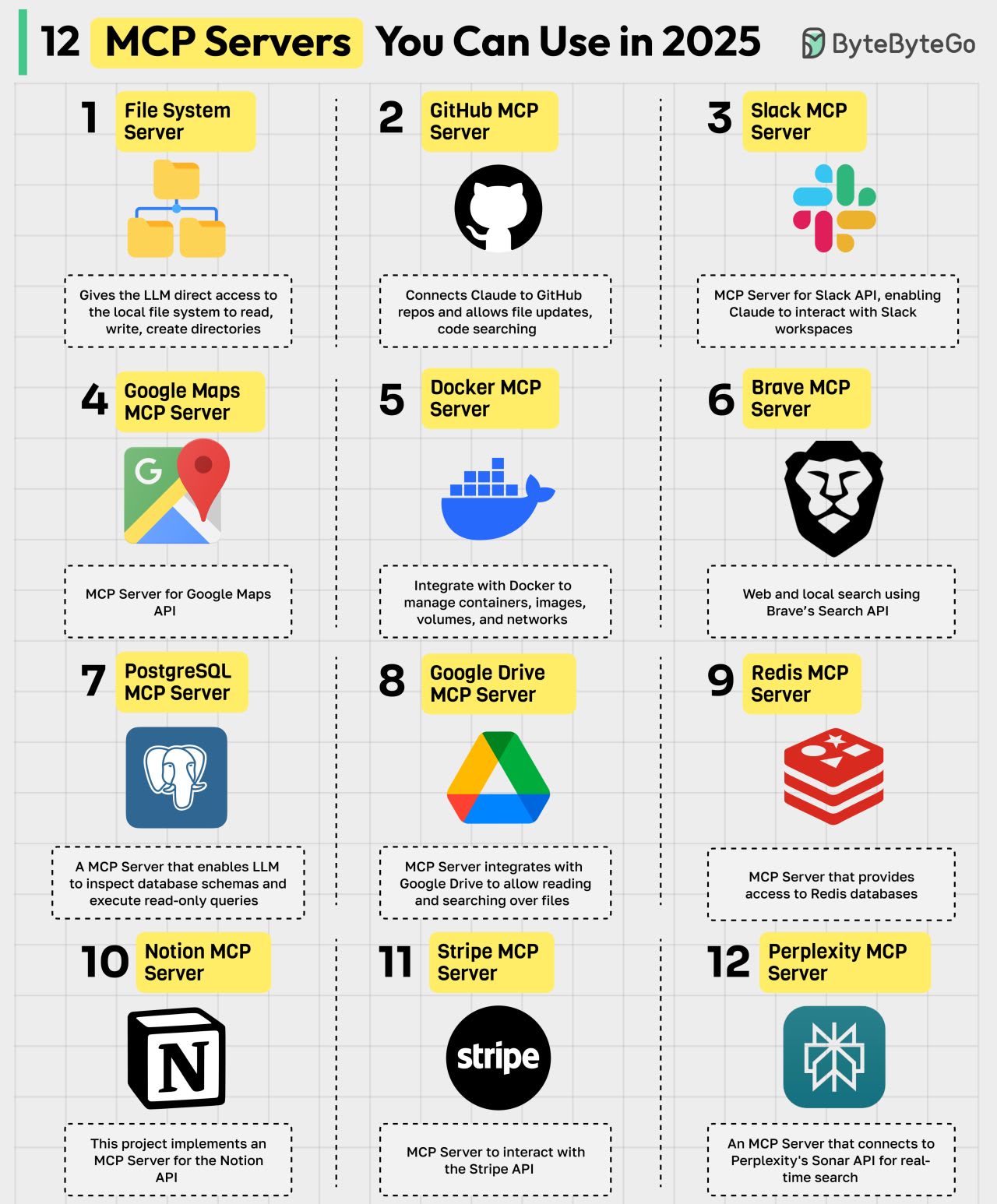The Ultimate Weapon for Software Architects (Sponsored)
What if you could instantly identify the only 3 functionalities to test for non-regression after modifying a complex Java class?
What if you could visualize the ripple effect, from database to front-end, of changing a column data type?
Master your application with the architects’ ultimate weapon
CAST Imaging automatically maps any application’s inner workings:
Visualize all dependencies & explore database access
Trace end-to-end data & call flows, assess change impact
Identify structural flaws typically missed by code quality tools
Stop wasting countless hours reverse-engineering your code manually.
Move faster with CAST Imaging, the automated software mapping tech.
CAST Imaging supports any mix of Java/JEE, .NET, Python, COBOL, SQL, and 100+ other languages, frameworks, and database engines.
This week’s system design refresher:
The Generative AI Tech Stack
24 Good Resources to Learn Software Architecture in 2025
ByteByteGo Technical Interview Prep Kit
Database Index Types Every Developer Should Know
The Agentic AI Learning Roadmap
12 MCP Servers You Can Use in 2025
SPONSOR US
The Generative AI Tech Stack
GenAI refers to systems capable of creating new content, such as text, images, code, or music, by learning patterns from existing data. Here are the key building blocks for GenAI Tech Stack:
Cloud Hosting & Inference: Providers like AWS, GCP, Azure, and Nvidia offer the infrastructure to run and scale AI workloads.
Foundational Models: Core LLMs (such as GPT, Claude, Mistral, Llama, Gemini, Deepseek) trained on massive data, form the base for all GenAI applications.
Frameworks: Tools like LangChain, PyTorch, and Hugging Face help build, deploy, and integrate models into apps.
Databases and Orchestration: Vector DBs (such as Pinecone, Weaviate), orchestration tools (such as LangChain, LlamaIndex) manage memory, retrieval, and logic flow.
Fine-Tuning: Platforms like Weights & Biases, OctoML, and Hugging Face enable training models for specific tasks or domains.
Embeddings and Labeling: Services like Cohere, Scale AI, Nomic, and JinaAI help generate and label vector representations to power search and RAG systems.
Synthetic Data: Tools like Gretel, Tonic AI, and Mostly AI create artificial datasets to enhance training.
Model Supervision: Monitor model performance, bias, and behavior. Tools such as Fiddler, Helicone, and WhyLabs help.
Model Safety: Helps ensure ethical, secure, and safe deployment of GenAI systems. Solutions like LLM Guard, Arthur AI, and Garak help with this.
Over to you: What else will you add to this list?
How Top Fintech Engineering Teams Actually Ship (Sponsored)
fintech_devcon is the technical conference where real builders share how they ship complex systems at scale.
Hear directly from engineers at Amazon, Block, Plaid, Chime, DocuSign, Gusto, and more.
Topics include:
💸Ledgers + payment infra
🔐 Onboarding, auth, and security
🧠 LLMs + fraud detection
🧰 Dev tooling + API design
💥 No sales pitches; just architecture diagrams, code, and battle scars
This is where fintech’s toughest engineering challenges get unpacked.
It’s all happening August 4–6 in Denver.
🎟️ Use BBG25 to save $195.
24 Good Resources to Learn Software Architecture in 2025
The resources can be divided into different types such as:
Software Design Books
Some books that can help are DDIA, System Design Volume 1 & 2, Clean Architecture, Domain-Driven Design, and Software Architecture: the Hard Parts
Tech Blogs and Newsletters
Read technical blogs by companies like Netflix, Uber, Meta, and Airbnb. Also, the ByteByteGo newsletter provides insights into software design every week.
YouTube Channels and Architectural Resources
YouTube channels like MIT Distributed Systems, Goto Conferences, and ByteByteGo can help with software architecture and system design. Azure Architecture Center and AWS Architecture Blog are other important resources.
WhitePapers
For deeper insights, read whitepapers like Facebook Memcache Scaling, Cassandra, Amazon DynamoDB, Kafka, and Google File System.
Software Career Books
A Software Architect also needs to develop holistic skills. Books about software career aspects such as Pragmatic Programmer, The Software Architect Elevator, The Software Engineer's Guidebook, and Philosophy of Software Design can help.
Over to you: Which other resources will you add to the list?
ByteByteGo Technical Interview Prep Kit
Launching the All-in-one interview prep. We’re making all the books available on the ByteByteGo website.
What's included:
System Design Interview
Coding Interview Patterns
Object-Oriented Design Interview
How to Write a Good Resume
Behavioral Interview (coming soon)
Machine Learning System Design Interview
Generative AI System Design Interview
Mobile System Design Interview
And more to come
Database Index Types Every Developer Should Know
A database index is a derived structure that maps column values to the physical locations of rows in a table. Let’s look at some key index types:
Primary Index
This index is automatically created when a primary key is defined on a table. Such an index can be dense as well as sparse, though sparse is preferred in most scenarios.
A dense index contains one entry for every row in the table. On the other hand, a sparse index contains entries for only some rows in the table.
Clustered Index
A clustered index determines the physical order of rows in a table. Only one clustered index can exist on a table because data can only be stored in one order at a time. It is great for range queries, ordered scans, and I/O efficiency.
Secondary Index
A non-clustered index is a separate structure that holds a copy of one or more columns along with pointers to the actual rows in the table. It doesn’t affect how data is physically stored, and it can use the primary index to locate the records.
Over to you: Which other index type will you add to the list?
The Agentic AI Learning Roadmap
An AI Agent is a system capable of autonomous actions, reacting to its environment, using tools (APIs, Internet, code, etc), and can work under human guidance.
To build AI agents, one must know tools like Python, Jupyter, PyTorch, and GitHub Copilot. These enable coding, experimentation, and integration with AI libraries and APIs.
GenAI Foundational Models
Familiarity with large models like GPT, Gemini, LLaMa, DeepSeek, and Claude is essential. These models provide the base intelligence that agents can use for reasoning, generation, and understanding.
AI Agent Development Stack
Tools like Langchain, AutoGen, Crew AI, and frameworks like Semantic Kernel and Hugging Face power agent workflows. These components manage tasks, memory, and external tool integrations in agent pipelines.
API Design
Understanding API design approaches like REST, GraphQL, gRPC, and SOAP is crucial to building interoperable agents. Key concepts include HTTP methods, status codes, versioning, cookies, headers, and caching.
Type of AI Agents
Learn about the several types of AI agents, such as simple reflex, model-based reflex, goal-based, utility-based, and learning agents. Each varies in complexity.
AI Agent System Architecture
AI agents can operate as single agents, in multi-agent systems, or in human-machine collaboration. Architecture depends on the use case.
Over to you: What else will you add to the AI Agent Learning Roadmap?
12 MCP Servers You Can Use in 2025
MCP (Model Context Protocol) is an open standard that simplifies how AI models, particularly LLMs, interact with external data sources, tools, and services. An MCP server acts as a bridge between these AI models and external tools. Here are the top MCP servers:
File System MCP Server
Allows the LLM to directly access the local file system to read, write, and create directories.
GitHub MCP Server
Connects Claude to GitHub repos and allows file updates, code searching.
Slack MCP Server
MCP Server for Slack API, enabling Claude to interact with Slack workspaces.
Google Maps MCP Server
MCP Server for Google Maps API.
Docker MCP Server
Integrate with Docker to manage containers, images, volumes, and networks.
Brave MCP Server
Web and local search using Brave’s Search API.
PostgreSQL MCP Server
An MCP server that enables LLM to inspect database schemas and execute read-only queries.
Google Drive MCP Server
An MCP server that integrates with Google Drive to allow reading and searching over files.
Redis MCP Server
MCP Server that provides access to Redis databases.
Notion MCP Server
This project implements an MCP server for the Notion API.
Stripe MCP Server
MCP Server to interact with the Stripe API.
Perplexity MCP Server
An MCP Server that connects to Perplexity’s Sonar API for real-time search.
Over to you: Which other MCP Server will you add to the list?
SPONSOR US
Get your product in front of more than 1,000,000 tech professionals.
Our newsletter puts your products and services directly in front of an audience that matters - hundreds of thousands of engineering leaders and senior engineers - who have influence over significant tech decisions and big purchases.
Space Fills Up Fast - Reserve Today
Ad spots typically sell out about 4 weeks in advance. To ensure your ad reaches this influential audience, reserve your space now by emailing sponsorship@bytebytego.com.









